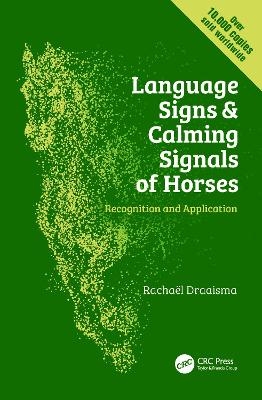
Language Signs and Calming Signals of Horses
CRC Press (Verlag)
978-1-138-07015-8 (ISBN)
This practical book helps you interpret and connect the physical signals that horses display in response to their environment. These signals are evident in the everyday actions, gestures and attitudes that horses communicate to each other, but are often so subtle that they can go unnoticed by humans. This book aims to rectify that, offering horse lovers and equine professionals an opportunity to gain a unique insight into their 'horse's world'.
Key features:
includes detailed description of language signs of domestic horses, with a special emphasis on calming signals
includes 275 pictures to visualize various language signs, calming signals, behaviour sequences and facial features
presents communication ladders to show how a horse responds to incentives in his environment, and what signals he uses at certain moments
contains tips on the use of the communication ladders and calming signals to improve the socialisation, training and wellbeing of your horse
considers equine psychological stress from an environmental perspective, providing a valuable alternative to the current common clinical perspective.
After reading this book you will be more astute in spotting calming signals, displacement activities, stress signals and distance-increasing signals, and better able to see which stimuli your horse can handle and which he cannot. This means you will know what to do to calm your horse before his stress rises to an unmanageable level. Language Signs and Calming Signals of Horses is both fascinating and important reading for any equine veterinary practitioner, student or nurse, as well as horse owners and trainers.
Rachaël graduated from the University in Nijmegen. She has always lived with and had a passion for dogs and horses. 15 years ago she decided to make it her profession. She achieved several diplomas and started working as trainer and behaviourist. First only with dogs and later also with horses. In 2013 she completed the TR (Turid Rugaas) International Dog Trainers Education. Under supervision of Turid Rugaas she started he study of calming signals of horses. Rachaël started filming domestic horses and analysing film material. The study grew and lead to a complete work shift from dogs to only horses. Rachaël also developed a (re)socialisation program for horses and nose work and games for horses. Rachaël travels (inter) nationally to give lectures. She dedicates her time to the ongoing study of language signs of horses.
1 THE DISCOVERY OF A LANGUAGE
1.1 Communication signal or not?
1.2 It all starts with a stimulus and a reaction
2 CALMING SIGNALS TO APPEASE AND CALM
2.1 What are calming signals?
2.2 Communication ladder calming signals
2.3 Body posture
2.4 Facial features & Tail carriage
2.5 Blinking
2.6 Half closing the eyes
2.7 Looking away
2.8 Chewing
2.9 Tongue-out chewing
2.10 Yawning & a Jaw stretch
2.11 Head turn
2.12 Neck turn
2.13 Neck Shake
2.14 Body shake
2.15 Lowering of the head and neck
2.16 Curving
2.17 Splitting
2.18 Showing the hindquarters
2.19 Showing the flanks
2.20 Eating
2.21 Immobility and slowing down
2.22 Summary Calming signals
2.23 Displacement Behaviour and Calming Signals Alternate
2.24 Communication ladder Displacement behaviour
2.25 Faces and behaviours
2.26 Displacement activities
2.27 Rolling
2.28 Head Swing
2.29 Example series
2.30 Summary Displacement behaviour
3 TENSION SHIMMERS THROUGH CALMING SIGNALS
3.1 Tension rises due to increasing stimulus intensity
3.2 Communication ladder Stress signals
3.3 Body posture and facial features
3.4 Clenched lips and different shaped lip and nose
3.5 More frequent defecation and urination
3.6 Rushing: eating, drinking and moving
3.7 Example of behaviour sequence
3.8 Tension leads to creation of distance
3.9 Communication ladder Distance increasing signals
3.10 Chasing away
3.11 Bite Threat
3.12 Threatening to kick
3.13 Bucking
3.14 The arched neck
3.15 Posturing behaviour
3.16 Flight signals
3.17 Example of a behaviour sequence
3.18 Fight or Flight
3.19 Communication ladder Fight/Flight
3.20 Recovery after mounting tension and shocks
3.21 Communication ladder Recovery after tension and shocks
3.22 Summary Rising tension and recovery
4 NO COMMUNICATION
4.1 Just not that interested
4.2 Communication ladder No communication signals
4.3 Withdrawal and stereotyped behaviour
4.4 Communication ladder Withdrawal
4.5 Summary No communication
5 APPLICATION OF CALMING SIGNALS: HOW DO WE HELP THE HORSE?
5.1 Communication ladder as an assessment tool
5.2 Planning and management
5.3 Creating relaxation opportunities
5.4 Do not leave your horse alone & use the hand signal
5.5 Using calming signals yourself
5.6 Splitting
5.7 Curving in an arc
5.8 Showing the flank or back
5.9 Standing still
5.10 Making your horse more independent: empower your horse
5.11 Chapter summary: tips
APPENDIX
1.1 Eyes
1.2 Ears
1.3 Notes
1.4 Bibliography of personal favourites
| Erscheinungsdatum | 21.10.2017 |
|---|---|
| Verlagsort | London |
| Sprache | englisch |
| Maße | 156 x 234 mm |
| Gewicht | 460 g |
| Themenwelt | Sachbuch/Ratgeber ► Natur / Technik ► Tiere / Tierhaltung |
| Sachbuch/Ratgeber ► Sport ► Reiten / Pferde | |
| Naturwissenschaften ► Biologie ► Zoologie | |
| Veterinärmedizin ► Großtier | |
| Veterinärmedizin ► Pferd | |
| ISBN-10 | 1-138-07015-7 / 1138070157 |
| ISBN-13 | 978-1-138-07015-8 / 9781138070158 |
| Zustand | Neuware |
| Informationen gemäß Produktsicherheitsverordnung (GPSR) | |
| Haben Sie eine Frage zum Produkt? |
aus dem Bereich


